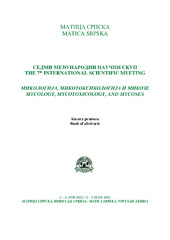Приказ основних података о документу
Occurence of Fusarium equiseti Corda (Saccardo) as causal agent of seed rot of Hyssopus officinalis L.
| dc.creator | Ignjatov, Maja | |
| dc.creator | Milošević, Dragana | |
| dc.creator | Aćimović, Milica | |
| dc.creator | Medic-Pap, Sladjana | |
| dc.creator | Ivanović, Žarko | |
| dc.date.accessioned | 2023-07-16T15:35:37Z | |
| dc.date.available | 2023-07-16T15:35:37Z | |
| dc.date.issued | 2022-06 | |
| dc.identifier.isbn | 978-86-7946-387-6 | |
| dc.identifier.uri | https://plantarum.izbis.bg.ac.rs/handle/123456789/767 | |
| dc.description.abstract | Hyssop (Hyssopus officinalis L.) is a perennial polymorphous plant species with essential oil mainly accumulated in the flowers and leaves. It is grown in Serbia for the needs of pharmaceutical companies and tea production, because of its quality and chemical composition. During a routine quality control of hyssop seeds collected from Rumenka (Vojvodina Province), in 2018, fungal infection followed by seed rot was noticed on an average of 22%. Infected seeds were covered with white mycelium followed with violet pigmentation occurring under the seeds. The presence of Fusarium spp. was confirmed with microscopic observation. Isolation was done aseptically by arranging infected seeds onto surface of potato dextrose agar (PDA), and incubated at 25 °C with a 12-h photoperiod (Mathur and Kongsdall, 2003). After seven days, 12 Fusarium spp. isolates were designated as JBL 4003/1 - 4003/12. Pathogenicity test was performed in vitro using a modified agar slant method in the test tube with PDA amended. After 10 days, fungal mycelia of tested isolates caused seed rot and seedling decay, like naturally infected hyssop seeds. All isolates were re-isolated and sub-cultured on Potato Dextrose Agar (PDA) and Carnation Leaf Agar (CLA) using a hyphal tip transfer technique, fulfilling Koch's postulates. Isolate JBL 4003/1 was distinguished based on pathogenicity and cultural characteristics. It caused seed rot after four days, on PDA colony was fast growing reaching 6-8 cm in diam. in five days, forming abundant, whitish to peach aerial mycelium followed with beige to light brown pigmentation in agar. Isolate formed relatively long and narrow macroconidia (24 to 54 × 3.2 to 4.5 μm) with a tapered and elongated apical cell and prominent foot-shaped basal cell, with four to six septate, with no microconidia. Chlamydospores were solitary and intercalary. Based cultural and morphological characteristics indicated that the isolate belong to species Fusarium equiseti Corda (Saccardo). To obtain a DNA sequence-based identification, total DNA was extracted directly from the mycelium. Following DNA extraction, the translation elongation factor 1-alpha region was amplified by PCR using the primer pair EF1 and EF2. The amplified and purified DNA fragment of chosen isolate JBL4003/1 was sequenced in both directions and deposited in the GeneBank under Accession Number MK061540.1. BLAST analysis revealed that the Serbian isolate MK061540 showed the highest nucleotide identity of 100% with F. equiseti isolates from United States (MG826890), Canada (KU587617), Turkey (KT286761), and Serbia (JQ412101). Based on morphological and pathogenic properties, as well as the sequence analysis, to our knowledge, this is the first case of F. equiseti Corda (Saccardo) as the causal agent of Hyssopus officinalis (L.) seed rot in Serbia. Considering the importance of H. Officinalis in pharmaceutical industries, knowledge of the composition of populations of Fusarium species transmitted by hyssop. | sr |
| dc.language.iso | en | sr |
| dc.publisher | Matica srpska | sr |
| dc.rights | openAccess | sr |
| dc.rights.uri | https://creativecommons.org/licenses/by/4.0/ | |
| dc.source | Knjiga rezimea, 7. međunarodni naučni skup "Mikologija, mikotoksikologija i mikoze", Novi Sad, 2-3. jun 2022 | sr |
| dc.subject | Fusarium equiseti | sr |
| dc.subject | seed rot | sr |
| dc.subject | hyssop | sr |
| dc.subject | Hyssopus officinalis | sr |
| dc.title | Occurence of Fusarium equiseti Corda (Saccardo) as causal agent of seed rot of Hyssopus officinalis L. | sr |
| dc.type | conferenceObject | sr |
| dc.rights.license | BY | sr |
| dc.citation.epage | 67 | |
| dc.citation.spage | 67 | |
| dc.type.version | publishedVersion | sr |
| dc.identifier.fulltext | http://plantarum.izbis.bg.ac.rs/bitstream/id/3001/bitstream_3001.pdf |


